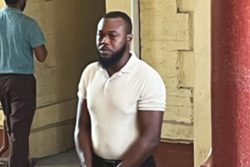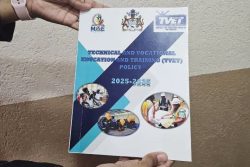While Guyana’s confirmed cases of novel coronavirus disease (COVID-19) remain at nine after almost three weeks since the first was confirmed, Minister of Public Health Volda Lawrence yesterday disclosed that it is projected that the country could record as many as 1,400 and she assured that the necessary measures are being implemented to handle the situation.
Lawrence made the disclosure during a press conference yesterday afternoon at the Police Training School, Eve Leary, where she also revealed that two of the infected persons are now Intensive Care Unit (ICU) patients.
“…We have used the PAHO [Pan American Health Organization] model to determine the number of projected cases for Guyana, which stands at 1,400…,” she said, before adding that the PAHO/WHO [World Health Organization] Epi-demiological profile projects that about 81% of the country’s cases will be moderate, 14% severe and 5% critical. “That is what we are using to model our preparedness and response,” she said.
According to Lawrence, preparations will be made for 100 persons who will require treatment in an ICU, 300 isolation beds nationwide and 730 beds for institutional quarantine.
As part of continuing efforts to contain and mitigate the further spread of this virus, Lawrence explained that the ministry will be strengthening community and hospital surveillance as well as the rapid response surveillance team.
She urged all leaders to make the protection of citizens a top priority. “This is a call for all of us to come on board with oneness. This is the time for us to actionalize the first statement in our motto—‘One people.’ Yes, one people. Let us all forge together as a unified body to fight this war on the coronavirus disease….fragmentation is not the approach at this time, I repeat fragmentation will not work,” she said.
Lawrence also called on persons to understand the seriousness of the virus, while noting, “Mr. COVID-19 has respect for no man”.
The disease, which causes respiratory illness, with symptoms including coughing, fever and difficulty breathing in more severe cases, had infected almost 635,000 persons and claimed almost 30,000 lives globally up to yesterday. Out of the eight confirmed cases here thus far, there has been one death.
Lawrence also disclosed that six of the cases are from Region 4, while one is from Regions 3 and the other from Region 6.
Lawrence also noted that the persons who have tested positive are six adults under the age of 60, one adult older than 60 years old, and a child.
She further noted that four of the confirmed cases are imported, while five are as a result of local transmission. “Of the total confirmed cases, the number of imported cases is 4 and local transmission 5,” she said.
During her update, the minister said that the total number of persons who have been tested has moved from 44 to 46, with eight positive cases, 37 negative and one inconclusive.
Thirty-six persons are under institutional quarantine. “Of the 7 persons in isolation, 2 are hospitalised in the COVID-19 ICU unit,” she said.
Guyana confirmed its first COVID-19 case on March 11, 2020, after a 52-year-old woman who had travelled from the United States to Guyana on March 5th died at the Georgetown Public Hospital (GPH).
Several persons who were on the flight with the woman were subsequently quarantined, while over 43 persons from the GPH were asked to self-quarantine after they came into contact with the patient. Eighteen persons related to the 52-year-old have also been asked to self-quarantine.
Four of the woman’s relatives have since been diagnosed with COVID-19.
The number of cases rose last Saturday when three other persons were diagnosed with the disease.
The three additional cases are not linked to the first five confirmed cases, nor are they linked to the community of Good Hope, East Coast Demerara, where the first local cases were recorded.
Stabroek News was previously told that one of the three persons returned to Guyana recently after travelling through a number of countries which are currently battling the disease.
The patient reportedly got sick after returning to the country and called the ministry hotline. A response team was sent to his home on the East Bank Demerara. He was interviewed before being taken to an isolation facility on the West Demerara, where he began displaying severe COVID-19 symptoms. He was then transported back to a facility in the city and was tested last Friday.
Lawrence revealed that as of Sunday, the calls made to the COVID-19 hotline number has increased from 856 to 998. Calls were received from seven of the ten administrative regions. No calls were recorded from Regions 1, 2 and 9.
Testing
Presently, Guyana has a total of 1,800 COVID-19 testing kits, which were donated by the PAHO/WHO.
Lawrence reiterated that there are “strict” guidelines which were set by PAHO/WHO and have to be followed before testing is done. Only persons who fit the “criteria” will be tested.
Director of Disease Control at Ministry of Public Health Dr Nadia Liu explained that the standard for testing, which was recommended by the WHO, is being used by the National Public Health Reference Laboratory—the only local facility that can test for COVID-19.
“A suspected case has three parameters and this is where we would use the suspect case as reasons for testing. The first parameter is that a patient will have a respiratory infection with a travel history to one of the countries that have declared infection with COVID-19 or there is a declaration of community transmission during 14 days prior to the onset of signs and symptoms; fever, cough, shortness of breath. The second scenario is a patient with acute respiratory infection, plus contact with a confirmed or probable case in the last 14 days prior to the onset of signs and symptoms. The third and the last scenario is a patient with a severe acute respiratory illness that requires hospitalization in the absence of an alternative diagnosis which explains the current signs and symptoms the patient is experiencing,” Dr Liu explained.
She added that there are specific types of samples that needs to be taken for testing. “…What we do recommend, which is the best option that PAHO/WHO has recommended to us, is a nasopharyngeal swab and/or the oropharyngeal swab that is taken and put in viral transport media and transported to the National Public Health Reference lab,” Dr Liu stated.
The test, she said, takes eight hours from the time received to time of completion of processing. “But there is a quality control measure that we have to follow. So usually the turnaround time from the time of taking the sample to the time we receive it at the lab is approximately 24 hours,” she noted before adding, “So when we say that you are COVID-19 positive, we are sure beyond the shadow of the doubt, you are positive.”
According to Dr Lui, the guidelines do not provide for everyone who desires to be tested. “If you look carefully to the three criteria, you will see we are almost testing everybody who has had a travel history, a community transmission, signs and symptoms suggesting COVID-19 and hospitalised in ICU. So you will see we are literally like throwing a seine to detect much more persons,” she said.
Deputy Chief Medical Officer Dr Karen Gordon-Boyle further explained that persons living in the areas where the confirmed cases were detected are only being tested if they manifest any signs or symptoms of the disease.
However, she noted that all suspected cases are under quarantine. “…They don’t pose threat to other people and these are people who have not yet shown signs and symptoms but there is a risk. Even when they show signs and symptoms, they become eligible for testing and they are tested,” she said.
“…And thankfully, we have enough tests at this point in time to be able to test those persons but if they don’t have signs and symptoms we are kind of wasting the test if we just go test them because they are worried….we cannot just test people who are worried, they have to fit the criteria,” Gordon-Boyle added.
As it relates to testing of health workers, Dr Lui said that this is a priority. “So we will also use the criteria for them. It’s not a case of if I know you and you know me, I could get a test. No. You have to fit the criteria. So once you follow one of the three criteria, we will rule you in and rule you out using the test,” she noted.
Contact tracing
Meanwhile, according to Gordon-Boyle, since the ports of entry are closed, persons who still enter the country under whatever means are automatically placed in institutional quarantine.
She said the surveillance unit has been “diligently” following up with all the persons who have been in contact with the confirmed cases and they are being monitored.
In this case, Gordon-Boyle said they develop a “line listing” of cases and contacts. Once the contacts are located, she said they are placed in home quarantine.
“So every case… we have eight persons who would have done a test and tested positive, all those cases, what the surveillance team has to do is to find every single case and to track that person’s movements from the time they entered Guyana. If you think about what that means, it means from the time they hit the airport, the immigration officers, the customs officers, the red caps, the taxis, people in their home, the market and everything that person would have done, the surveillance officer would have to now track where they would have travelled to, the persons they would have met and interview every single one of those persons,” Gordon-Boyle explained.
She noted that a “large” number of persons who are currently in quarantine will soon complete the 14-day period. “…But there are a number of them, at one time they were a hundred and something and that number has dropped because they have passed the 14 days quarantine period. They never developed signs and symptoms, so they no longer under surveillance and so it’s a systematic process. People are coming on surveillance and people are coming off surveillance. People who develop signs and symptoms will be tested,” Gordon-Boyle related.








